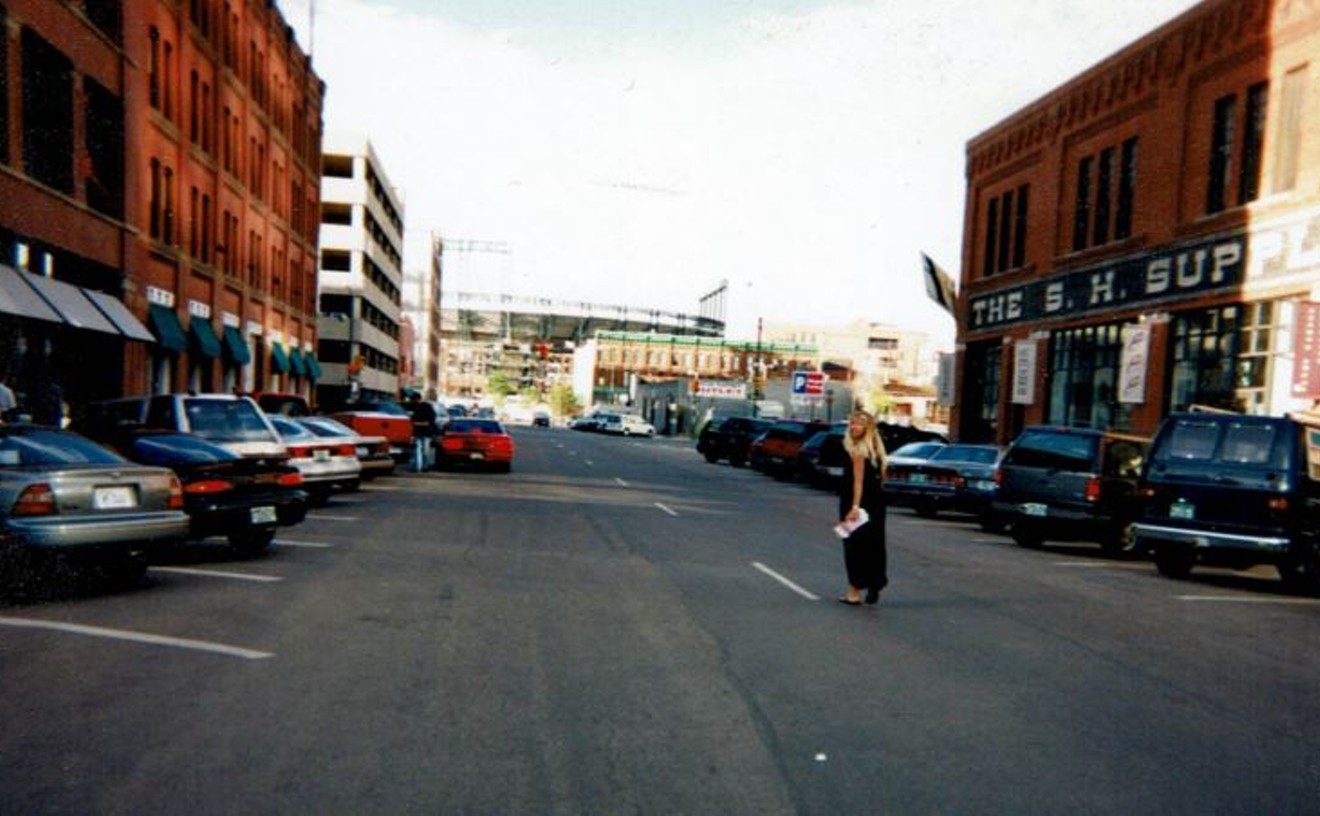The recent uproar over the KKK cop painting created by a tenth-grader and displayed in the Wellington Webb Municipal Office Building got us thinking about this city's colorful past with public art — and by “colorful,” we mean “sometimes fucked up.”
Art, of course, is in the eye of the beholder. To paraphrase Supreme Court Justice Potter Stewart (who at the time was talking about obscenity), we as a public collective can’t always define art, but we “know it when [we] see it.” It's just that so many of us are seeing something completely different when we behold the same thing. And so some of the controversies, like the art that inspired them, never die. Here are ten more pieces that have inspired endless discussion:
10. Blucifer
Let’s start with Denver International Airport’s unofficial welcoming committee, the demon-eyed cerulean giant of a horse that, by the way, killed its creator, Luis Jiménez. This is not a metaphor. It’s a landmark for Denver these days, as people who fly in and out of DIA can’t help but see it and react to it in some way, either positively, negatively...or both. Citizens definitely have a love-hate relationship with the piece, which is officially named “Blue Mustang,” and this is evident from the fact that it’s often simultaneously named as the most and least favorite piece of Denver public art, starting back in the 2011 DIA Art Master Plan.
9. The Yellow Wall
At least artist Herbert Bayer didn't try to be cute with his “Articulated Wall”; Bayer passed away in 1985, the same year that the sculpture debuted in Denver. One of the earliest pieces on this list, this fixture of the Denver cityscape (at least from I-25) used to be controversial until most of the other pieces listed here came about, and this quickly went from “Huh?” to “Oh, I like that wall.” But that could be because over the past three decades, the piece has picked up the friendly nickname "Stack of French Fries."
8. That Big Pile of Kidneys Down by the Freeway
John McEnroe’s sculpture (officially known as “National Velvet,” which Elizabeth Taylor would almost certainly protest were she still around) is ensconced on the east side of the pedestrian footbridge connecting downtown to Highland, squatting right in the center of the roundabout circling from the bridge down to the ground. That revolution gives viewers a 360-degree look at the thing, and plenty of opportunity to say “What the hell?” And it has done so now for nearly a decade.
7. The Inexplicable Broom and Dustpan
Artists Claes Oldenburg and Coosje van Bruggen say that this sculpture, located outside the Denver Art Museum, was inspired by the sight of Denver sanitation workers “demonstratively sweeping trash into dustpans.” (How one sweeps in a specifically “demonstrative” manner is anyone’s guess.) The piece is titled “Big Sweep,” and it’s often referred to as “whimsical,” which is what you say when something doesn’t really make sense but you don’t want to come out and say that. Compared to another Denver Art Museum piece, "The Yearling" (commonly referred to as “The Horse on the Chair”), though, "Big Sweep" inspires far fewer “Oh, how whimsical” comments and a lot more “Yep, that’s a ginormous dust pan, all right.”
6. Burns Park
It’s sort of an oddity, this little triangle of space along South Colorado Boulevard just north of Leetsdale. The installations here are the remnants of a 1968 experiment in creating a sculpture park (then a radical and inventive notion, as no such thing existed at the time), and only two of the eight originals are still standing. The controversy involves the city’s willful lack of support for the park's upkeep back in the day: In response to artist Robert Mangold’s protests that his spire wasn’t being properly maintained, the city metaphorically flipped him the bird and, in a shortsighted fit of pique, demolished it. It’s a shame that the park’s oasis-like existence is sandwiched between busy streets with very little parking to allow visitors to enjoy it as a park experience. Still, it's a nice break in the visual landscape while navigating Colorado Boulevard, isn’t it?
Read on for five more controversial art pieces in Denver.
5. Dancing People
Sometimes called “The Aliens,” this Jonathan Borofsky installation is actually named “The Dancers,” and portrays what can most accurately be described as two towering, articulated drawing mannequins in '70s disco poses. The music floating up from below doesn’t really help, since very few people actually walk to the base of the sculpture, barring the rare festival that happens in the relatively tiny green space of Sculpture Park in which it sits. "Dancers" owes a great debt to "Blue Mustang," because before Blucifer came along, it was this couple of big white weirdos that Denver people loved to hate.
4. The Peeping Tom Bear
Granted, the Big Blue Bear sounds like some sort of Disney show (and was, under the name Bear in the Big Blue House). But the real name of Lawrence Argent’s installation is the just-as-precious “I See What You Mean,” which is the sort of pun-for-pun’s-sake title that usually gets wrung out of artists at the graduate workshop level. It’s also disturbingly reminiscent of the Charmin bears that are obsessed with wiping their hairy backsides with thoroughness and then talking about it among themselves and with company. (Others seem to have embraced the scatological reference as well.) Still, the Big Blue Bear has become beloved to kids and visitors alike, so it must be doing something right.
3. What Could Have Been Named “An Invitation for Vandalism”
When Denver artist William F. Joseph named Civic Center Park’s Christopher Columbus statue “Christopher Columbus: Discoverer of America,” he probably didn’t think he was doing anything controversial at all. The name is mundane and straightforward, and this was 1970, a time when Columbus was no more a polarizing figure than other holiday namesakes like Abraham Lincoln or St. Patrick. But in the past 45 years, things have most definitely changed. In 1989, Russell Means, actor and American Indian Movement activist, threw fake blood all over the statue, and it has been defaced in similar ways several times since.
2. The Shrouded Fountains at DIA
No, you’re not remembering incorrectly: There did, in fact, used to be a huge, usually shut-down fountain in the middle of what’s now a giant expanse of marble tile in the main terminal at DIA, right where the trains deliver their incoming passengers. Doug Hollis’s water sculpture was called “Mountain Mirage,” and, boy, did it live up to the second half of its name, because it was almost never there. Constant leakage and water-pressure issues caused it to be more of a hassle than it was worth to try and fix, and so it was completely removed in recent years. Now only the weird “Notre Denver” Suitcase Gargoyles dare speak its name — that is, when they’re not busy telling horror stories of the infamous, disastrous and also-removed automated baggage system.
1. DIA
Arguably Denver’s most identifiable piece of art, this list comes full circle with the Denver International Airport as an artistic piece itself. Designed by Fentress Bradburn Architects, the airport was meant to recall both the snowcapped mountain ranges to the west as well as the traditional Native American teepee, and become a gateway for air travel west of the Rockies. It’s also become something of a legend in and of itself, the center of several interconnected conspiracy theories including but by no means limited to: the suggestion that it looks like a giant Nazi swastika from the air; that it’s part of a worldwide Masonic conspiracy; and that a series of disturbing Leo Tanguma murals included in the public art commissioned for the airport’s wall space suggest (among other things) prior knowledge of the 9/11 terrorist attacks. Back in 2007, the AM radio show Coast to Coast with George Noory devoted a whole four-hour block to the darkness hiding within the bowels of DIA — which you can download and listen to the next time you’re stuck at the airport because of snow.
[
{
"name": "Air - MediumRectangle - Inline Content - Mobile Display Size",
"component": "12017618",
"insertPoint": "2",
"requiredCountToDisplay": "2"
},{
"name": "Editor Picks",
"component": "17242653",
"insertPoint": "4",
"requiredCountToDisplay": "1"
},{
"name": "Inline Links",
"component": "18838239",
"insertPoint": "8th",
"startingPoint": 8,
"requiredCountToDisplay": "7",
"maxInsertions": 25
},{
"name": "Air - MediumRectangle - Combo - Inline Content",
"component": "17261320",
"insertPoint": "8th",
"startingPoint": 8,
"requiredCountToDisplay": "7",
"maxInsertions": 25
},{
"name": "Inline Links",
"component": "18838239",
"insertPoint": "8th",
"startingPoint": 12,
"requiredCountToDisplay": "11",
"maxInsertions": 25
},{
"name": "Air - Leaderboard Tower - Combo - Inline Content",
"component": "17261321",
"insertPoint": "8th",
"startingPoint": 12,
"requiredCountToDisplay": "11",
"maxInsertions": 25
}
]











